MG Abingdon – Changing Times Part 2
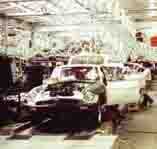
 Throughout the 1960s, BMC had been content to let ltalian coachbuilder Pinin Farina take care of their styling requirements whilst the Corporation’s own design department concentrated on the vehicle engineering, mostly under the guidance of Alec lssigonis. lndeed it was Farina who created the extremely successful Coupe (or GT) version of the MGB.
Throughout the 1960s, BMC had been content to let ltalian coachbuilder Pinin Farina take care of their styling requirements whilst the Corporation’s own design department concentrated on the vehicle engineering, mostly under the guidance of Alec lssigonis. lndeed it was Farina who created the extremely successful Coupe (or GT) version of the MGB.
By the end of the decade things began to change, however. Firstly when BMH was formed, a small styling department was set up at Pressed Steel, Cowley, and following the merger with the Leyland group, the Austin Morris division decided to set up their own styling studio at Longbridge. The stylists were recruited from Ford UK, which had one of the largest in-house studios in Europe. The hope was that Austin Morris could emulate the success that their Dagenham rivals were enjoying in the marketplace, particularly with cars such as the Escort and Cortina. Longbridge would concentrate on the Austin range whilst another ex-Ford recruit, Roy Haynes, based at Cowley, would design the next Morris car (the ADO2B Marina) along more conventional lines. Whilst the ADO28 project had been signed off by the board, the Austin Morris studio had materialised too late in the day to salvage anything from the Maxi project, which was already in the throes of being tooled up for production.
It was inevitable therefore that the Longbridge studio would soon have the somewhat aging MGB and Midget in their sights. Perhaps mercifully for Abingdon there was no money in the kitty for any panel changes so after reviewing other aspects of the cars, it was decided that a change of frontal aspect would be the key area of focus. The radiator grille with its vertical chrome slats was considered to be somewhat old fashioned and in need of a makeover. lt also offered an opportunity to save a little cost at a time when every penny counted, although this was never proven. However in its place appeared an inset black mesh to which was fitted a simple rectangular chrome finisher, inside which, was located the (barely discernable from some angles) MG badge. The whole thing was finished off with a chrome finisher surround on the forward edges of the bonnet, wings and front apron. Both the ‘B’ and the Midget featured this mini facelift which was introduced for the 1970 model year. Other changes included front and rear sidemarker lamps for the North American market and rubber inserts in the overriders.
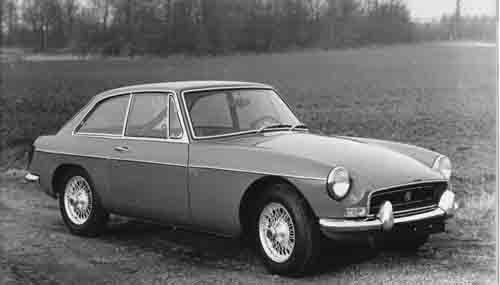
Unfortunately no one at Abingdon really liked the new grille but not even John Thornley could stop it happening. It later transpired that the Americans, still Abingdon’s largest customer, didn’t like the new front grille treatment either. ln fact, within a couple of years the original grille surround was reinstated, largely as the result of lobbying from the USA, but the black mesh stayed in place of the vertical slats. There would, however, be worse to come not because of any action by styling, but as the result of the ever increasing demands of US legislation, more of which later. Fortunately the new front end treatment didn’t affect sales in America and production continued to increase.
May 1971 saw the all too soon retirement of Abingdon’s Chief Engineer, Syd Enever. After 51 years with MG, and having been involved at every level of design and development, including racing and record breaking as well as the manufacture of tanks and aircraft during WW2, he was now rather disgracefully being put out to grass. The man who had produced the company’s two most successful MG sports cars and delivered more international speed records than anyone before or since, now found himself the victim of corporate bureaucracy. The new chairman, Donald, now Lord, Stokes, had decreed that anyone and everyone in British Leyland must, without exception, retire at 65, so any plans Syd may have had of staying on in a consultancy role were quickly dashed. Roy Brocklehurst now took over the reins with his main responsibility being to ensure the Abingdon cars were kept abreast of the regulations, most of which continued to emanate from the United States.
By this time the mid-engined ADO21 project had more or less fizzled out with the top management opting rather unsurprisingly for the Triumph 2-seater project as the next Leyland sports car. However, good fortune had not completely deserted MG. Lord Stokes had shown more than a passing interest in the Costello Rover V8-engined MGB that had been getting quite a bit of press exposure around this time. Ken Costello had set up a small cottage industry building and selling these conversions to people who were willing to pay to have a considerable increase in power under the bonnet. The beauty of this ex-Buick all-aluminium engine, now being manufactured in the UK by Rover, was that its all up weight was no more than that of a standard B-series unit. The result of his Lordship’s interest was a phone call from Charles Griffin to Costello asking to see one of these conversions at Longbridge.
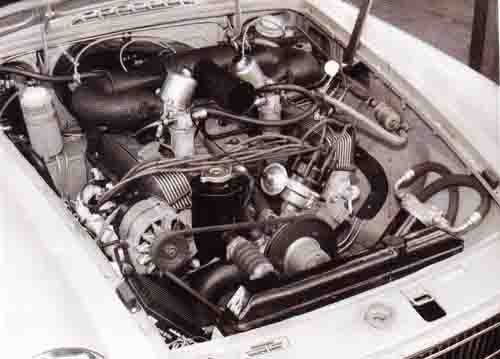
After a quick (with quick being the operative word), drive around the locality (Charlie Griffin had lost none of his old road testing skills), Abingdon were instructed to build a similar prototype for his appraisal. Roy Brocklehurst undertook to have this ready within a month, thus entailing a great deal of burning of the midnight oil. Given the experimental number EX249, the car was ready for viewing by early September 1971, and by the following January had been allocated the project number ADO75. By all accounts the Triumph orientated management were lukewarm about the idea, so we have to assume that it was Lord Stokes’ enthusiasm for the project that pushed it through. Changes to the body structure were minimal, helping to keep the whole exercise cost effective.
It had been decided from the outset to limit this engine to the B GT as it was felt that this was the stronger of the two body shells and thus able to absorb the high torque levels consistent with this engine. Another reason was that Abingdon were already being warned that the supply of engines would inevitably be limited. This restriction also ruled out sending this model to the US market. Various theories have been advanced down the years (including that of possible conspiracy) but the fact remains that it was a Rover engine and they were understandably in no hurry to jeopardize their own production requirements. The flow of engines was of necessity limited at this time and they quite rightly felt that they should have first priority regarding supplies for both the new 5D1 saloon and the Range Rover; whose low compression version MG shared.
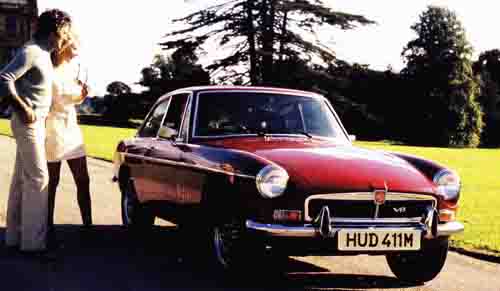
Interestingly, it was Lord Stokes, the model’s original champion, who launched the MGB V8 in August 1973 and through no fault of their own the company’s timing couldn’t have been worse. Within weeks of the launch, a war in the Middle East struck a cruel blow to Abingdon’s new car, leading to a major fuel crisis in the UK as oil supplies became strictly limited. Overnight the emphasis was on fuel economy; something not particularly on the V8’s list of priorities. With the V8 only available in RH drive form, there was little Abingdon could do but to grin and bear it.
Back in 1971, at about the time that the VB was first being discussed, another event went almost unnoticed. This was the ending of production of the MG 1300 Saloon. Both it, and its sister car the MG1100, had offered the public a small family saloon in the best traditions of the MG brand: good performance, excellent road holding allied to a comfortable ride and a well appointed and spacious interior. For virtually the first time in its history, there would be no 4-seater in the MG range. From now on if you wanted an MG, then you would, of necessity, have to buy a 2-seater. Whilst this may have suited some of the purists who never really considered the post-Z Magnette saloons to be ‘proper’ MGs anyway, it was something of a disaster for the MG franchise holders in the UK, who now had a pretty limited range of cars to sell.
With the US regulations now in full swing, the American insurance industry decided to lobby the federal government regarding no-damage bumpers. Nothing really to do with safety, but at that time insurers were getting a huge amount of claims resulting simply from their drivers’ poor parking skills. Their argument was that if bumpers did more of what they were originally intended for instead of being merely there for decorative purposes, then costs would be considerably reduced. As an interim measure, a requirement was initiated for overriders to have rubber inserts. This measure was introduced for MG for 1970 model year cars.
For the 1972 model year, resulting from changes to the padded fascia legislation, it was now possible to once again have a glove box on the passenger’s side. In fact the entire US MGB fascia panel was restyled by Longbridge to also include face level vents and a new console panel. This was a great improvement over the rather heavy looking ‘pillow’ fascia that had been necessary previously.
In June 1973 everyone at Abingdon was surprised to hear the announcement that Roy Bucklehurst was leaving the fold to take up a rather more senior position at Longbridge. Roy had been given the position of chief engineer, volume passenger vehicles for Austin Morris, reporting directly to Charles Griffin. This, of course, left an empty seat at Abingdon which was quickly filled by Don Hayter, with Dave Seymour, who had recently moved to Abingdon and had previously had the distinction of working with Alec Issigonis on the Mini programme, taking over responsibility for all regulatory issues. Don had, since the demise of ADO21, spent some time working on SSV1, the first of a series of British Leyland safety vehicles. SSV1, based on an MGB, was used to demonstrate a number of forward thinking ideas to hopefully make cars safer in the future.
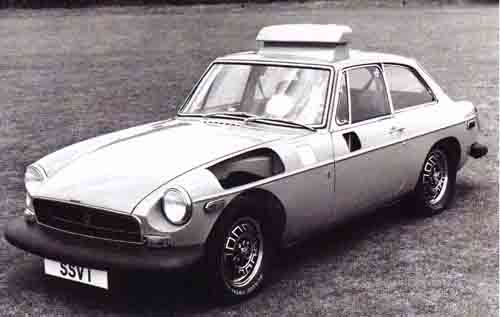
Abingdon suffered another shock later in the year when it was announced that general manager, Les Lambourne, would be leaving MGs after 15 years to take up a position as Director of RALPO (radiators and light pressings operations) in Oxford. His replacement would be Bob Ward who had previously been working at Longbridge, a fact that made some people at Abingdon decidedly nervous. Bob would, however, prove to be a worthy successor to Les and worked hard to keep everyone focused on producing cars for the American market.
Once again the US no-damage bumper legislation raised its ugly head, this time demanding a solution that resulted in the fitment of massive and uncompromising rubber overriders for the 1974 model year. This was only a beginning however, as, for the following year, Abingdon would have to develop front and rear bumpers that would withstand a 5mph impact with no visible damage.

After studying several different alternatives, the Abingdon body design team, headed once more by Jim O’Neill, settled on a solution, which incorporated a large, one-piece polyurethane moulding, attached to a heavy steel armature. This, in turn, necessitated beefing up the underframe, adding further unwanted weight. To add insult to injury, to meet the bumper height requirement, it was also necessary to jack the suspension up, which did nothing to aid the handling of the car.
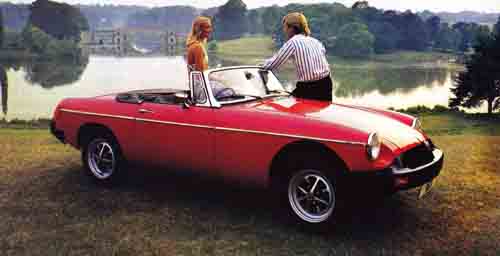
Once again the styling had been undertaken by Longbridge who did about the best job possible in the circumstances. For the sake of rationalization it was decided to fit the new bumpers to RHD cars too: a decision that did not go down too well with the UK motoring press. In the case of the Midget there was further controversy. In addition to the new polyurethane bumpers it was revealed that the 1975 model year cars would also be fitted with the 1500cc Spitfire engine! The purists couldn’t believe what was happening: a Triumph engine in an MG! What a terrible state of affairs!! As it happens, this was not part of a grand conspiracy by a Triumph obsessed BL management but rather a means to an end. The fact was that resources available to Longbridge/Engines Branch were insufficient to develop both ‘A’ and ‘B’ series and Triumph would concentrate on de-toxing an uprated version of the Spitfire engine which would then be shared with the Midget. Even a Midget with a Triumph engine was preferable to no Midget at all.
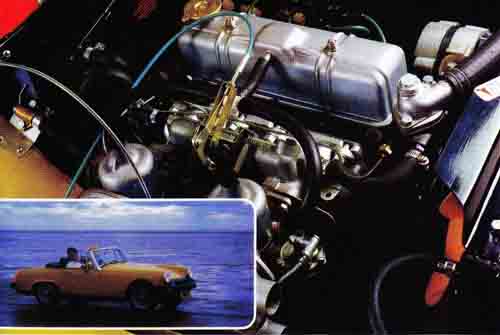
1975 also saw the introduction of the Triumph R7, British Leyland’s brand new corporate 2-seater sports car. Meanwhile Abingdon waited with bated breath.
Our thanks once again to Andy Knott, Editor Safety Fast, and author, Peter Neal, for their permission to reprint this article.

